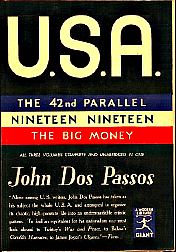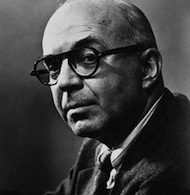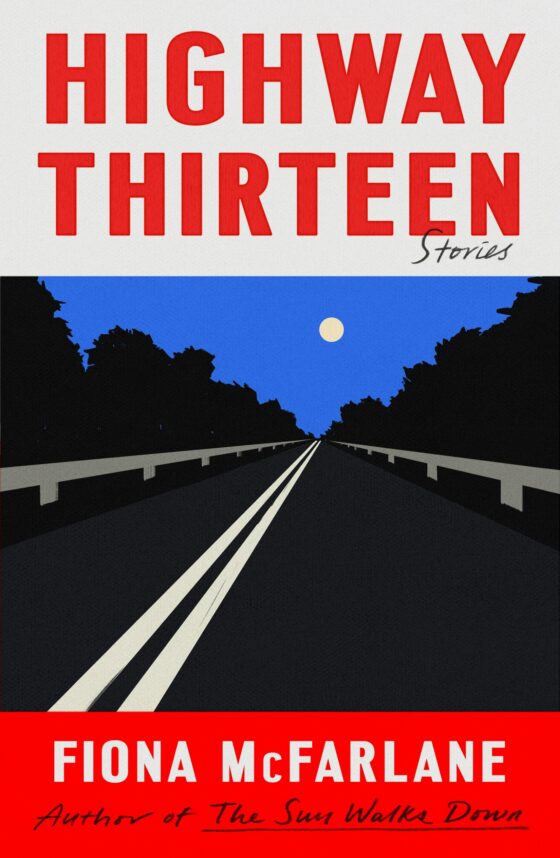
I’m not sure that any writer today is writing fiction as contemporary in substance as that which John Dos Passos was writing in the 1920’s and 30’s. Precarious, exploited youth; economic catastrophes; senseless warmongering; cynical self-promoters; feckless media beholden to entrepreneurial myths: the U.S.A. trilogy has it all. Dos Passos died in 1970, but behind his prose a reader can sense the presence of an intelligence that somehow, anachronistically, understands our maddening yet hopeful times. Unfortunately, U.S.A. has suffered its share of high-profile detractors, and the reputation of the novelist that Jean-Paul Sartre called “the greatest writer of our time” isn’t what it once was.
On March 16, 1997, the New York Times published a takedown of John Dos Passos’s U.S.A. trilogy by the theater critic Richard Gilman. Gilman says that Dos Passos “was basically a reporter on a mission,” necessary for his time (the 1930s, with “its unrest and savagery,” as Gilman puts it) but irrelevant for the 1990s. Gilman concludes by telling us that “in a different atmosphere it feels rather dated, labored, in its best places no more than a ‘good try.’” Earlier this year, in the Los Angeles Review of Books, on the 75th anniversary of the novel’s publication, the critic Ted Gioia reheated Gilman’s earlier argument: that Dos Passos
The historical progress in literature’s subject matter gradually elevated the struggles of regular people to what had once been the epic reserve of heroes and kings. But Dos Passos doesn’t elevate anybody. The lives of U.S.A.’s characters, as they are presented to us by Dos Passos, don’t follow smooth narrative arcs. Our own lives are like this, too. That might bother Gioia, but it’s what Satre thought made U.S.A. special. It’s hard to imagine a reader of the U.S.A. trilogy that doesn’t feel a strange recognition, no matter how many years have passed since the book’s publication. While the revolutionary milieu that was the source of many of the book’s events may have vanished, we have our own milieu.
Sartre’s essay, “On John Dos Passos and 1919,” collected in the brand-new NYRB Classics original We Have Only This Life to Live, claims that “we immediately recognize the sad abundance of these untragic lives […] In capitalist society, people do not have lives; they only have destinies.” The tragedy is collective, not individual. But that’s not Dos Passos’s fault. Sartre stresses the particularities of the lives of Dick, Eleanor, Daughter, et al., but reminds us that in his time “social life has marked them more deeply than any particular circumstance could, since they are that social life.” In the age of social media with its joys, anxieties, and distractions, it’s hard not to feel that we need a dose of U.S.A. even more than Dos Pasoss’s and Sartre’s contemporaries did. Luckily for us, the book happens to be perfect subway reading. All of its little sections are addictive, and the pages fly by like free verse; each could nearly stand on its own as a poem, and it would be a shame if readers ignored this vital book that Sartre loved but that Gioia dismisses as a “morass of sloganeering and bluster.”
U.S.A.’s haters tend to focus on the weakest sections of the book, which Dos Passos calls “the Camera Eye”: 51 semiautobiographical, semi-successful stream-of-consciousness prose poems. Gioia speculates that perhaps the only reason the Camera Eye sections are in the book is to “impress us that John Dos Passos is a bold, experimental fellow who refuses to be hemmed in by traditional narrative techniques.” Dos Passos wasn’t a first-year MFA student at Brown, and the Camera Eye sections make up only a small percentage of the text. To make a debate about the novel a debate about those short sections diverts our attention from what’s actually being said. Much more important to Dos Passos’s project are his witty biographies of varied figures like J.P. Morgan, Eugene Debs, Isadora Duncan, and Randolph Bourne, in which Dos Passos shows that these famous figures were products of circumstance in just the same way that U.S.A.’s major characters in the novel’s long narrative sections. The Camera Eye and the 67 “newsreels” that also punctuate the text provide the context that novels typically take for granted. The absurd brusqueness with which Gioia mocks Dos Passos belies his motive for hating the book: that there are too many leftists among the cast of characters, and that there’s something aimless or random about the text. In 2013, it’s strange to see either of these things as problems. We live in a time in which there hasn’t been a book more universally praised than Roberto Bolaño’s 2666, whose structure is much looser than U.S.A.’s.
The novels that have been written since the financial crisis began in 2008 seem antiquarian next to U.S.A. Gioia claims that U.S.A. is outdated—a failed epic by a writer out of his depth. This seems wrong, since many of the struggles Dos Passos’s characters face have reasserted themselves grimly over the last five years. In our interconnected, post-crash Occupy Wall Street age, we have seen novels that only glancingly narrate the problems that Dos Passos foregrounds. In U.S.A., many characters are fired unfairly, experience surprise medical mishaps, or lose their homes. In our age of foreclosures, precarious working conditions, and unaffordable health care, it’s useful to know that these problems have been part of the historical American experience even if they’ve often been below the regard of writers. This piling up of misfortune in U.S.A. brings these things to the level of the political and makes the tragedy of the novel societal rather than individual. The sum of the narratives exposes the lies at the heart of the so-called American Dream summed up on the last page of the book: “went to school, books said opportunity, ads promised speed, own your home.” While things might have seemed rosier in the 90s, the problems of history Dos Passos’s characters deal with remain primary.
There’s no novel that brings us to as many locales in America (and the broader world, as seen by Americans) than U.S.A. Dos Passos’s willing portrait of a country on the edge of revolt—or at least a kaleidoscope of characters inhabiting such a country—counters many of the received ideas of what Americans are like. Gioia says that “maybe U.S.A. the country stands for democracy, but U.S.A. the novel doesn’t acknowledge its existence”—but Dos Passos is more interested in cataloging democracy’s absence. Even if Dos Passos didn’t get everything right, there’s a freshness to the work that’s apparent to anyone who’s read a lot of Hemingway or Fitzgerald.

Gioia says that, for Dos Passos’s characters, “the occasional conflicts and dramas of their lives are overwhelmed by all the posturing and blustering” of the political sort. This implication that U.S.A. is cold, that abstract politics overwhelms the characters’ humanity in some way, has been repeated many times, but it’s nonetheless baffling. Take the scene that Janey Williams, a young woman from the Georgetown section of Washington, calls the best day of her life. She meets her brother Joe and his friend Alec (who she loves, secretly) to go for a canoeing trip on the outskirts of the city. A storm comes, and they hide under the canoe:
Alec’s towsled black hair was against her cheek. The other side of her Joe lay with his head in the end of the canoe and his lean brown feet and legs in their rolledup pants tucket under her dress. The smell of sweat and riverwater and the warm boysmell of Alec’s hair and shoulders made her dizzy. When the rain came drumming on the bottom of the canoe curtaining them in with the lashing white spray, she slipped her arm round Alec’s neck and let her hand rest timidly on his bare shoulder. He didn’t move.
Later, Alec dies, and Janey throws herself into work. We become very close to her very quickly (as we do with most of the characters) early in The 42nd Parallel, but we eventually see her from many other perspectives, too—usually as a nearly-anonymous woman in the background of the P.R. pioneer J. Ward Moorehouse’s office. These overlapping views of Janey make her early-life disappointment all the sadder. She’s a woman who seems so static in the eyes of others, but we know that things could’ve gone differently for her.
What’s most remarkable about what Dos Passos pulls off is that he’s able to balance a close personal free-indirect narration with a view of the totality (history, capitalism, war) without compromises. It’s up to the reader to infer the connections between the macro and the micro: news headlines and characters’ thoughts, biographical sketches of business titans and vignettes in the life of an indefatigable secretary, World War I and relationship troubles. Dos Passos sacrifices the pure joy of narrative arcs for a philosophically undogmatic left-wing framework for understanding humanity in an era of big economic and technological changes. But that’s not to say that the characters get lost: if anything we feel for them more because they’re presented to us in this strange new way unlike more conventional storytelling.
Joe Williams is Janey’s brother. He deserts from the Navy in Buenos Aires and becomes a sailor on commercial boats. His slangy sections of the novel also produce much of its most vivid imagery. The Spanish coast he sees from his Brooklyn-based ship the Appalachian is “scattered little white houses like lumps of sugar.” Not everything is beautiful, though, even on the night he learns that World War I has ended. On Armistice Day Joe reveals his latent racism and gets into a fight in St. Nazaire with a Senegalese French officer who had been dancing with the woman Joe believes is his whenever he’s in town. “Wazamatta cherie,” she says, before a bottle crashes over his head. Dos Passos’s use of colloquialisms is precocious; there were countless phrases that seemed to pop up from out of time throughout U.S.A. The word “comeback,” for example, is used just the way we use it today, and it’s hard to imagine many such words slipping into the prose of Dos Passos’s contemporaries. Dos Passos wrote in unvarnished colloquial language for the same reason that he refused to tell neat yarns: he wanted his readers to think about the way that society hurts even unexceptional people.
Alfred Kazin in his essay “Dos Passos and the Lost Generation” said that “from the first to the last Dos Passos is primarily concerned with the sanctity of the individual”—individuals who are broken down by capitalism and its attendant crises and wars. Kazin recognized that there was nothing contradictory in grounding a critique of society in the idiosyncratic specificity of the lives Dos Passos tells us about. When we examine each of these stories one after another, we’re able to see that for all their diversity the characters’ sicknesses are shared sicknesses, sicknesses that a sensitive reader yearns to cure. Over time the conventional thinking about Dos Passos has shifted from Kazin’s and Sartre’s appreciation of Dos Passos’s placement of characters in an oppressive historical context to a kind of vague assertion by the likes of Gilman and Gioia that Dos Passos didn’t care at all about his characters, or that Dos Passos had some kind of doctrinaire agenda that overrode their dignity. But Dos Passos’s art laments the limited agency of his characters. The very thing that Dos Passos wants to indict American society for, his opponents want to pin on him. The book is scary to a lot of people only because it’s deeply, openly pessimistic about the culture of our nation in a way that other writers confine to the bounds of just one particular plotted story at a time.
Two of the most salient characters in the book, Eleanor Stoddard and J. Ward Moorehouse, whose lives intertwine in a complex friendship, are an interior decorator and a P.R. man respectively. These two professions are, if anything, more emblematic of our own time than they were of Dos Passos’s—today everyone has their own P.R. department on social media. We’re all gawking at others’ curated, decorated lives on our phones. Sartre claims that “Dos Passos reports all his characters’ words in the style of press releases.” In the 75 years since U.S.A. was published, our U.S.A. has only tended in the direction implied by the narrative. Sartre calls this narrative a process “unfurling their tissue of ritual declarations and sacred acts.” This roll of tissue unfurls not unlike our scrolling Twitter feeds and Facebook Timelines. These tendencies which were new in the time of U.S.A. are now generalized. The newsreels especially read as precursors to the way we learn about the world today. These collages of loosely-related textual ephemera, principally newspaper headlines and snippets of articles, deftly and ironically convey the zeitgeist. A reader in 2013 will discover that zany news stories (and their appreciation) predate the web by many decades.
This refraction from what life may have once been is also dramatized through the way aviation inventor Charley Anderson’s vitality seems to be sucked out of him by the vortex of the stock market during the boom years of the 1920s. In one of the key images of The Big Money, Charley Anderson sits in his stockbroker’s office, looking out the window at New York Harbor:
He got to the broker’s office a little early, and sat waiting in an empty office looking out through the broad steelframed windows at the North River and the Statue of Liberty and the bay beyond all shiny ruffled green in the northwest wind, spotted with white dabs of smoke from tugboats, streaked with catspaws and the churny wakes of freighters bucking the wind, checkered with lighters and flatboats, carferries, barges and the red sawedoff passengerferries. A schooner with grey sails was running out before the wind.
He’s waiting for Nat Benton, his stockbroker, who comes into his office late, apologizing. Charley tells Nat that he’s “been enjoyin’ the view.” Nat’s response: “ ‘View? . . . Sure. . . . Why, I don’t believe I look out of that window from one week’s end to another. . . .’ ” It’s maybe too fitting that the guy who spends his time trading abstract financial instruments would miss the view. As Charley’s fortune waxes and wanes with Benton’s help, he learns to miss things too, and he eventually dies in a car crash.
These characters are all well off, even if they aren’t born that way. Dos Passos counters this increasingly through the novel’s presentation of working-class characters, like Mac (Fainy McCreary) and Ben Compton, who struggle through lives of left-wing militancy. Mac ends up as possibly the happiest character in the book: at the end of The 42nd Parallel, he decides to stay in Vera Cruz amid the Mexican Revolution with his new Mexican family. Compton, who has his own section near the end of 1919, is an intellectual. His Jewish family own their home in Flatbush when he is a child; his father falls ill, and “they lost the house which was almost paid for and went to live in a flat on Myrtle Avenue.” When he’s young he thinks that “when he grew up he’d be a lawyer and a business man and make a pile quick so that Gladys could quit work and get married and the old people could buy a big house and live in the country.” On a trip to Pennsylvania to toughen himself up on a doctor’s advice, Ben meets an Italian kid named Nick Gigli, and his dreams change. Nick comes from a family of anarchists from northern Italy; he “told Benny about Bakunin and Malatesta and said Benny ought to be ashamed of himself for wanting to get to be a rich businessman”—Nick says he should learn, but learn instead for the revolution and the working class. Ben’s colorful left-wing career pushes him on through life, lands him in jail, and brings him together with and pulls him away from lovers.
Ben Compton and his first lover, Helen Mauer, an anarchist he meets at a talk at Cooper Union, live together in a bedbug-infested room on the Lower East Side:
He had to go out to a drugstore to buy some safeties because she said how could she have a baby just now when they had to give all their strength to the movement. There were bedbugs in the bed, but they told each other they were as happy as they could be under the capitalist system, that someday they’d have a free society where workers wouldn’t have to huddle in filthy lodginghouses full of bedbugs or row with landladies and lovers could have babies if they wanted to.
Are Ben and Helen’s cute dreams naive? There’s irony in the voice Dos Passos relates them, appropriately, since these two are very young. Helen doesn’t believe in monogamy; they live in “free union” and eventually break up. But their bedroom dreams seem pretty reasonable if you think about it—don’t we all want bedbugless housing and the financial security to reproduce when we’d like? In New York, in 2013, many of us still have neither.
Another of Compton’s old flames, Mary French, is a Vassar dropout who throws herself into the labor movement. The trilogy ends with two deaths which Mary learns about nearly simultaneously: those of Eveline Hutchins and of Mary’s friend Eddy. Eveline, who becomes something of a socialite during The Big Money, kills herself with sleeping pills after one of her big parties. Eddy, on the other hand, is shot by an anti-communist gang and is found dead in a ditch in Pennsylvania. The juxtaposition of these two deaths says a lot about how Dos Passos causes his readers to think about class—Eveline, whose catchphrase is “it’s just too tiresome,” does to herself what vigilantes do to Eddy.
In “Vag,” the epilogue to the trilogy that immediately follows these revelations, Dos Passos posits the eponymous young vagrant hitchhiker as representative of the country. This isn’t the recreational travel of the Beats. The Vag watches as an airplane flies by; the transcontinental passengers “are saluted by doormen; telephonegirls say gooddmorning to them” fly by. One vomits a New York meal in the air over Las Vegas, but “no matter, silver in the pocket, greenbacks in the wallet, drafts, certified checks, plenty restaurants in L.A.” while the Vag is still standing by the side of the road waiting for a ride “a hundred miles down the road.” One imagines an Instragram of Malbec from first class via Wi-Fi. Sartre says that Dos Passos “infuriates those who have never been infuriated before” and “frightens those who are frightened of nothing.” So it’s fittingly the Vag who we’re left with after weeks of reading. By design U.S.A. might not always be elegant, but neither is America. Once we’re done reading, we’re newly revolutionary, as Sartre says in his essay on Dos Passos, “to my very core—and against myself.” He shows us that literature can incite this transformation; it’s something that hasn’t been attempted often enough. Bringing out indignant feeling is a noble calling for a novelist, and it’s a grand accomplishment that Dos Passos can still make us mad 75 years later.




